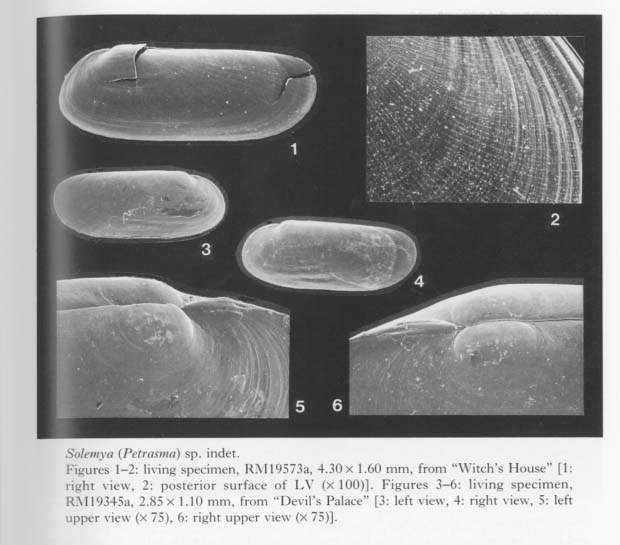Class Bivalvia Linnaeus, 1758
Subclass Cryptodonta Neumayr, 1884
Order Solemyoida Dall, 1889
Superfamily Solemyoidea Adams and Adams, 1857
Family Solemyidae Adams and Adams, 1857
Genus Solemya Lamarck, 1818
Subgenus Petrasma Dall, 1908
Solemya (Petrasma) sp. indet.
Figures 1-6

A few individuals of a small solemyid have been found alive on the bottom sediments of "Devil's Palace" (UMUT RM19345) and "Witch's House" (RM19573) of Shimoji Islet and "Cross Hole" (RM19346) of Irabu Islet, Miyako Islands.
The elongated oblong outline and opisthodetic subinternal ligament suggest subgenus Petrasma for this species. The subgeneric reference is, however, by no means convincing, because the detailed structure of the chondrophore is unknown. The surface is shiny, marked with several weak radial threads in addition to numerous divergent striae. There is a small post-umbonal flange supporting the subinternal ligament. Unlike many solemyids, the periostracum of this species is thin and scarcely extends beyond the ventral margin of calcareous shell.
The present species looks different from Solemya (Petrasma) pusilla Gould, 1861, from the shallow-waters of north-central Japan, having a much smaller size (the maximum specimen in the present sample is only 4.8 mm long), undeveloped periostacum and a more elongated outline. If the difference in size is ignored, the shell shape is similar to that of Solemya (Acharax) japonica Dunker, 1882, from the lower sublittoral bottom of north-central Japan, but the ligament is subinternal, unlike that species. The present specimens probably belong to an undescribed species, but further examination is needed because of the possibility that they represent merely juvenile stages.
Superfamily Nucinelloidea Vbkes, 1956
Family Nucinellidae Vokes, 1956
Genus Huxleyia Adams, 1860
The shell orientation of nucinellids was determined by Allen and Sanders (1969), who studied the soft part of Nucinella serrei Lamy in detail. They regarded the Nucinellidae as belonging to the Solemyoida in terms of anatomy. The phylogenetic relation of this family was discussed again by Waller (1990). From a viewpoint of cladistics, he considered that the hinge teeth of Nucinella and Huxleyia are of palaeotaxodont type (instead of actinodont type) and that the origin of this family should be sought in a primitive Ordovician group also ancestral to the Solemyidae and Ctenodontidae.
Although Habe (1958, pl.11, fig.16, as cited by Keen and Newell in Cox et al., 1969, fig.C14) indicated the presence of posterior adductor muscle scar in Huxleyia snlcata Adams, 1860, the type-species of this genus, all the species of Huxleyia seem to be monomyarian, as pointed out by Allen and Sanders (1969) and Matsukuma, Okutani and Tsuchi (1982) on Nucinella species.
The bathymetric distribution of Huxleyia species in the Pacific has been regarded as restricted to lower sublittoral to upper bathyal soft bottoms (Habe, 1977a; Bernard, 1983; etc.). The abundant occurrence of living individuals of a species of this genus in sublittoral caves is remarkable.
|
